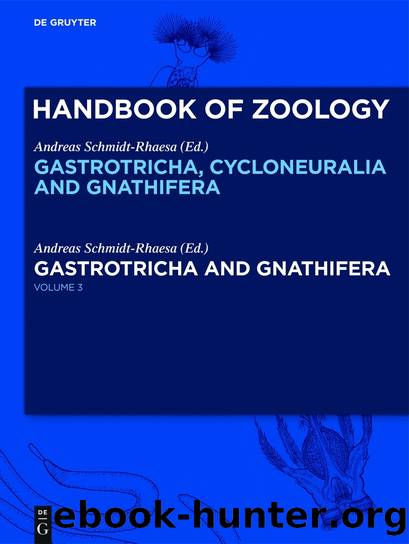Gastrotricha and Gnathifera by Schmidt-Rhaesa Andreas;Kükenthal Willy;Schmidt-Rhaesa Andreas;

Author:Schmidt-Rhaesa, Andreas;Kükenthal, Willy;Schmidt-Rhaesa, Andreas; [Schmidt-Rhaesa, Andreas]
Language: eng
Format: epub
Publisher: De Gruyter, Inc.
Published: 2014-12-06T00:00:00+00:00
Martin V. Sørensen and Reinhardt M. Kristensen
3 Micrognathozoa
3.1 Introduction
Micrognathozoa is a taxon that currently consists of one single species, Limnognathia maerski Kristensen & Funch, 2000. Limnognathia maerski is a microscopic, acoelomate, vermiform animal that ranges in size from about 100 µm to 150 µm (Figs. 3.1â3.5). The body can be divided into three main regions: a head, an accordion-like thorax, and an abdomen. The integument on the dorsal and lateral sides consists of plates that are made up by 1â4 epidermal cells. A body cuticle is generally lacking, but dorsally, the epidermal cells are supported internally by an intracellular protein lamina and externally by a thin glycocalyx. The epidermal cells on the ventral side do not form plates, but are covered by a thick glycocalyx that resembles the thin cuticle found among species of annelids. Besides scattered ciliary sensory bristles, the dorsal and lateral parts of the integument have no ciliation, whereas the ventral side has ciliary bands anterior and lateral to the mouth. Furthermore, two rows of ciliophores extend throughout the ventral side of the thorax and abdomen to the caudal adhesive ciliary pad. A ventral mouth leads through a pharynx with a highly complex jaw apparatus to a short esophagus and a midgut that extends through the thorax and anterior part of the abdomen. An anal opening is either absent or at least present temporarily only. Excretion is done through pairs of protonephridia. Only females have been observed, and males are, if present at all, probably highly reduced and present within a very narrow time span only (Kristensen & Funch 2000, Kristensen 2002).
Limnognathia maerski is periphytic and psammobi-ontic; it lives among submerged mosses and in the sediment of freshwater bodies. It has been recorded from polar and boreal regions, but is best known from its type locality at Disko Island in West Greenland. The species was first discovered during a biological field course at the Danish Arctic Station on Disko Island in 1994. During the course, a group of students and researchers camped on the northeast coast of the island, at a place called Isunngua, to examine the meiofauna of the homothermic springs in the area and at the sandy beach nearby. The campsite was situated next to a cold, heterothermic spring that was used to supply drinking water and water for sample processing. During a routine check of the meiofauna inhabiting this spring water, the new taxon Micrognathozoa was discovered.
The discovery prompted 6 years of detailed research on the new entity until a comprehensive description could be published by Kristensen & Funch (2000). Further detailed observations and interpretations of the pharyngeal apparatus were subsequently published by De Smet (2002) and Sørensen (2003). The phylogenetic position of Micrognathozoa was addressed by Ahlrichs (1995a, b) and Sørensen et al. (2000) using a morphological approach and subsequently by Giribet et al. (2004) using molecular sequence data. A contribution to the groupâs geographic distribution was given by De Smet (2002) who recorded the species from the Subantarctic island Ile de la Possession in the Crozet Islands archipelago.
Download
This site does not store any files on its server. We only index and link to content provided by other sites. Please contact the content providers to delete copyright contents if any and email us, we'll remove relevant links or contents immediately.
| Amphibians | Animal Behavior & Communication |
| Animal Psychology | Ichthyology |
| Invertebrates | Mammals |
| Ornithology | Primatology |
| Reptiles |
Sapiens: A Brief History of Humankind by Yuval Noah Harari(14254)
The Tidewater Tales by John Barth(12609)
Mastermind: How to Think Like Sherlock Holmes by Maria Konnikova(7228)
Do No Harm Stories of Life, Death and Brain Surgery by Henry Marsh(6891)
The Thirst by Nesbo Jo(6829)
Why We Sleep: Unlocking the Power of Sleep and Dreams by Matthew Walker(6618)
Life 3.0: Being Human in the Age of Artificial Intelligence by Tegmark Max(5474)
Sapiens by Yuval Noah Harari(5294)
The Longevity Diet by Valter Longo(5021)
The Body: A Guide for Occupants by Bill Bryson(4975)
The Rules Do Not Apply by Ariel Levy(4863)
The Immortal Life of Henrietta Lacks by Rebecca Skloot(4526)
Animal Frequency by Melissa Alvarez(4395)
Why We Sleep by Matthew Walker(4361)
The Hacking of the American Mind by Robert H. Lustig(4319)
Yoga Anatomy by Kaminoff Leslie(4306)
All Creatures Great and Small by James Herriot(4233)
Double Down (Diary of a Wimpy Kid Book 11) by Jeff Kinney(4208)
Barron's AP Biology by Goldberg M.S. Deborah T(4100)
